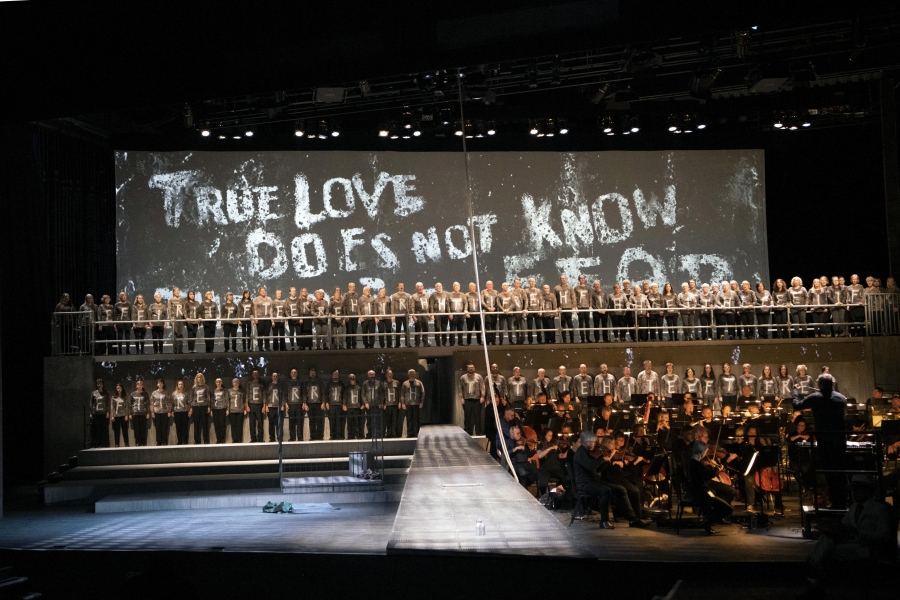The latest instalment in the WNO’s Freedom season is an interesting double bill hinging on the theme of unjust imprisonment and the hope for its reversal, warranted or otherwise. The first half, Dallapiccola’s opera in one act The Prisoner, is a tale of hope for liberation, thwarted; the second half, covering the events of the second act of Beethoven’s Fidelio, a tale of hope for liberation, achieved. In this sense, the two halves of the evening are clearly meant to be mirror images of each other, and this is signalled in a variety of ways, starting with the sharing of the same stage setting, through the use of similarly drab costumes dominated by hues of gray, and ending with the recurring appearance of the same singer, baritone Lester Lynch, in different roles in the two halves. This latter choice is particularly charged, as Lynch plays the titular prisoner in the first act, offering moving, deeply human rendition that is sure to rouse sympathy in its audience, and then returns as the villainous Don Pizarro, himself the enactor of unjust imprisonment, in the second half. The use of the same interpreter for both parts surely cannot be coincidental, and it adds an interesting layer of unspoken commentary on human nature, and on the fact that, depending on circumstances and chance, any of us could find themselves to be the victim or the perpetrator of injustice. Credit must go to Lynch for giving weight to this element through equally poignant performances, though his delivery of the Prisoner is particularly incisive and lingers in the memory far more after the end of the evening.
Lester Lynch and Peter Hoare
This is also a general trend with the production as a whole: by the end of it, one is left with the impression that the first half is generally stronger than the second. This is partly because The Prisoner is complete within its one act, while the narration in the second act of Fidelio, while in a sense self-conclusive, still displays a number of loose threads that leave the audience somewhat frustrated in the feeling that there is more to the tale than they are being shown. Partly, also, it is due to the fact that The Prisoner is, as a work in itself, stronger as an operatic performance, with its striking character arc and its emotional introspection, than Fidelio, which is far more focussed on the music than it is on its narration. Not by chance, the outstanding parts in the second half are by and large the choral sections, with yet another striking performance by the WNO chorus, looking increasingly like the voice of emotion through the works in this Freedom season. Nevertheless, the performance of Gwyn Hughes-Jones as Florestan, dignified through his imprisonment and liberation, is worthy of mention as it gives weight to a character that is presented to the audience stripped of his backstory. Also notable, in the first half, are the performances of an emotional but dignified Sara Fulgoni as The Mother, and Peter Hoare as both the Jaoler and the Grand Inquisitor, echoing one part in the other in what is probably the most chilling moment in the whole evening.
The lack of a backstory for the protagonist of the second act of Fidelio, on the other hand, might also be read as an intentional choice. We do not know exactly what the backstory of the eponymous Prisoner is, either; only that he has somehow fallen foul of King Philip of Spain and the Spanish Inquisition. In removing the backstory of Don Florestan, making it apparent only through hints, the two prisoners are put on equal grounds, and a further thread between the two halves of the production is established in putting a spotlight on the depersonalisation that comes with unjust imprisonment. The anonymous Prisoner and Florestan are equally reduced to the status of non-person through the injustice that is inflicted upon them; only through his liberation Florestan regains the right to his name and identity, while the Prisoner, cruelly mocked by his tormentor, is destined to remain forever anonymous. Overall, it is a slightly unbalanced but well thought-through production, showing mirror images of the same scene, and two possible resolution of the same dilemma, starting with despair and ending with hope.
A minor, but somewhat annoying technical note has to do with the surtitles, that were, in the first half, somewhat threadbare, sacrificing much of the meaning and the beautiful poetic imagery in the original libretto. This is unusual for surtitles at the WNO, which are usually detailed and on point, and it did, I suspect, detract some of the appreciation for an otherwise very impactful for the non-Italian speakers in the audience.

